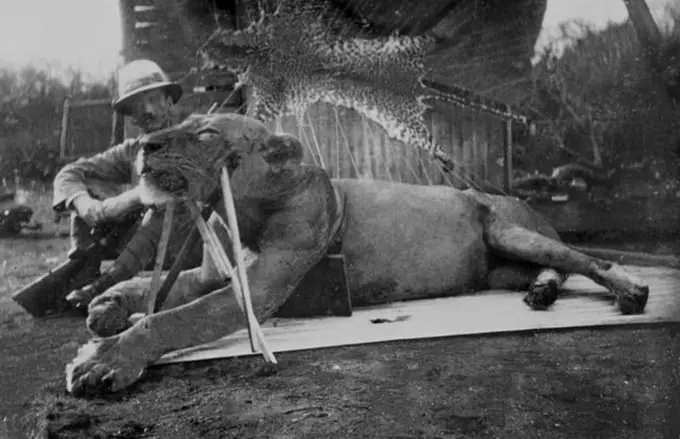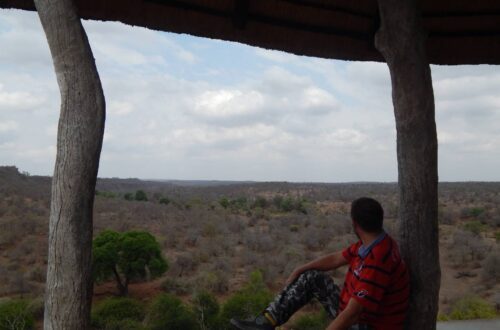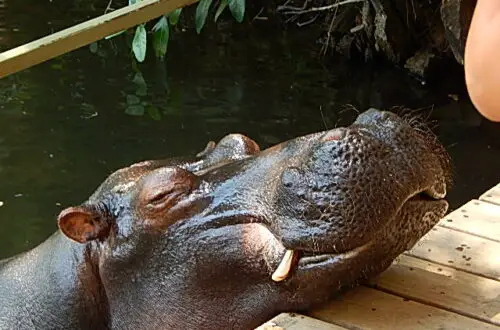The Bloodthirsty Beasts: The Legendary Man-Eaters of Tsavo East.
The Infamous Man-Eaters of Tsavo
The African wilderness has long been a realm of both wonder and danger, where the untamed beauty of nature intertwines with tales of primal savagery. Among the many stories that have captured the imaginations of adventurers and scholars alike, few are as chilling and bloodcurdling as the legend of the man-eaters of Tsavo.

These fearsome predators, a pair of maneless male lions, terrorized the Tsavo region in Kenya during the construction of the Uganda Railway in the late 19th century. Their ruthless attacks on humans became the stuff of nightmares.Their reign of terror left an indelible mark on the colonial history of East Africa. This article delves into the harrowing encounters with the man-eaters.Explores the historical and ecological context of Tsavo.Examines the impact on local communities, and delves into the enduring fascination and legacy of these bloodthirsty beasts.
Historical Context: Exploring Tsavo’s Dark Reputation
Colonial Expansion and the Building of the Railway
Picture this: it’s the late 19th century, and the British Empire is spreading its wings, conquering new lands, and building railways to connect its vast territories. Tsavo, in present-day Kenya, was one such location that became crucial for the construction of the Uganda Railway. Little did the railway workers know what awaited them in the wilderness of Tsavo.
Tsavo’s Wilderness: A Haven for Predators
Tsavo wasn’t your average safari destination. It was a wild, untamed land teeming with all sorts of creatures, including some of Africa’s most formidable predators. With its dense vegetation, rocky hills, and abundant prey, Tsavo offered the perfect hideout for lions, the undisputed kings of the savannah. But little did these lions know that they were about to become infamous for all the wrong reasons.
Encounter with the Man-Eaters: A Terrifying Battle for Survival
The Construction Site: A Perfect Hunting Ground
Imagine working on the railway, surrounded by the African wilderness, with the rhythmic sounds of construction filling the air. It all seemed so peaceful until the man-eaters decided to crash the party. The Tsavo lions realized that railway workers made for a scrumptious alternative to their usual diet, turning the construction site into their very own buffet.
Escalating Attacks: The Panic Among Railway Workers
As the man-eaters grew bolder and attacks became more frequent, panic spread among the railway workers. These beasts were cunning, stealthy, and seemingly unstoppable. The men lived in fear, devising all sorts of strategies to outsmart the predators. But the man-eaters had the home advantage, and it seemed like the battle between man and beast would never end.
Col. John Henry Patterson shot the lions and sold their bodies for $5,000 to the Field Museum in Chicago, where, stuffed, they greet visitors to this day.
Unraveling the Mystery: Understanding the Behavior of Tsavo’s Man-Eaters
Maneless Male Lions: Unusual Characteristics
The Tsavo man-eaters were a peculiar duo. Firstly, they were both male lions, a deviation from the typical lion hunting pattern where females take the lead. But what truly set them apart was their lack of manes. These maneless males were often associated with aggression and dominant behavior, which might have contributed to their insatiable appetite for human flesh.
Lack of Prey and the Impact on Lion Behavior
Now, let’s talk about the dinner menu. Tsavo’s man-eaters didn’t become man-eaters overnight. It’s believed that a scarcity of their usual prey, like buffalo and zebra, forced them to turn to an unconventional food source: us humans. When food is scarce, survival instincts kick in, and desperate times call for desperate measures. These lions had simply adapted to their environment, and unfortunately for us, we became part of their survival strategy.
So there you have it, the untold tale of the man-eaters of Tsavo. A story of a treacherous wilderness, a clash of humans and animals, and a lesson in the resilience of nature. Remember, next time you’re hiking in the African savannah, keep an eye out for those untamed beasts, and maybe pack an extra snack, just in case. Stay wild, my friends!
The Impact on Local Communities: Tales of Fear and Loss
Devastating Attacks on Villages and Livestock
The reign of terror unleashed by the man-eaters of Tsavo had a profound impact on the local communities living in the area. Villages were subjected to devastating attacks, leaving villagers in a constant state of fear. The man-eaters showed no mercy, preying on both humans and livestock alike. These attacks not only resulted in the loss of precious lives but also decimated the livelihoods of the villagers who relied on their livestock for survival.
Economic and Psychological Consequences
The economic consequences of the man-eaters’ presence were dire for the communities surrounding Tsavo. With their livestock being killed, villagers faced significant financial losses, impacting their ability to sustain themselves. The psychological toll was equally significant as fear and anxiety gripped the hearts of the villagers. Everyday activities became a nerve-wracking ordeal, with constant fear of encountering the bloodthirsty beasts.
The Myth vs Reality: Examining the Legacy of Tsavo’s Man-Eaters
Hollywood’s Interpretation: The Ghost and the Darkness
Hollywood immortalized the man-eaters of Tsavo in the 1996 film, “The Ghost and the Darkness.” While the movie added a touch of dramatization, it captured the essence of the sheer terror that these man-eaters instilled. However, it is important to separate the myth from reality. The man-eaters were not supernatural beings, but rather two exceptional lions driven by unique circumstances to prey on humans.
Scientific Debates: Dissecting the Man-Eaters’ Motivations
Scientists and experts have engaged in ongoing debates about the motivations behind the man-eaters’ behavior. Some argue that their preference for human flesh stemmed from the scarcity of their usual prey due to drought during that period. Others believe that the man-eaters learned to associate humans with an easy source of food, leading to their predatory behavior. The scientific examination of the man-eaters’ motivations sheds light on the complexities of wildlife behavior and the delicate balance of nature.
Conservation Efforts and Lessons Learned: Protecting Wildlife and Humans
Implementing Protective Measures in Tsavo National Park
In the wake of the man-eaters’ rampage, efforts were made to protect both wildlife and humans in Tsavo National Park. The park authorities implemented measures to minimize human-wildlife conflicts, such as constructing barriers and trenches to keep predators at bay. These protective measures aimed to ensure the safety of both wildlife and the neighboring communities.
Coexistence and Community Education Programs
Recognizing the importance of coexistence between wildlife and humans, community education programs were introduced to foster understanding and awareness. These programs aimed to educate local communities about the behavior of wildlife. Providing them with the knowledge and tools to mitigate conflicts and reduce the risk of future man-eater situations. By promoting coexistence, conservation efforts sought to protect both the magnificent wildlife of Tsavo and the lives of the communities living in proximity.
The Enduring Fascination of Tsavo’s Man-Eaters
The story of Tsavo’s man-eaters continues to captivate people around the world, serving as a reminder of the power and unpredictability of nature. The impact on local communities was immeasurable, with tales of fear, loss, and resilience etched into their collective memory. The legacy of the man-eaters, both in myth and reality, has spurred scientific discussions, Hollywood adaptations, and conservation efforts. By learning from the lessons of the past, we strive to create a world where humans and wildlife can coexist in harmony and fear will no longer dominate the narratives of Tsavo’s man-eaters.
The man-eaters of Tsavo continue to captivate our imagination. Serving as a haunting reminder of the delicate balance between humans and wildlife in the African wilderness. Their reign of terror may have come to an end, but their legacy lives on, inspiring further research, conservation efforts, and the exploration of the complex dynamics between predators and prey. As we strive to protect both wildlife and human communities, the story of Tsavo’s man-eaters serves as a poignant reminder of the primal forces that shape our world, and the ongoing quest for harmony in nature’s untamed realms.
FAQ:
Were the man-eaters of Tsavo truly exceptional in their behavior?
The man-eaters of Tsavo, two infamous lions that killed and devoured over 130 railway workers in Kenya during the construction of a bridge in the late 19th century, were indeed exceptional in their behavior. As depicted in Colonel Patterson’s written account, these lions exhibited unique characteristics that set them apart from other predatory animals. Their unusual choice of attacking humans rather than traditional prey is a striking anomaly among lion behavior.
Moreover, their seemingly strategic approach by specifically targeting individuals within heavily guarded camps demonstrated an exceptional level of intelligence and adaptability. Various theories have been proposed to explain their aberrant behavior, including tooth decay or chronic illness affecting their ability to hunt usual prey. However, regardless of the underlying cause, it is clear that the man-eaters’ distinct actions and impact on human societies make them extraordinary specimens worthy of extensive study and fascination for professionals in fields such as animal behavior and conservation biology.
What were the motives behind the man-eaters’ attacks on humans?
The motives behind the Tsavo man-eater’s attacks on humans can be ascribed to a combination of factors. Firstly, it is important to note that these two male lions were infamous for their unnatural preference for human flesh, which deviates from the usual hunting behavior of lions in the region. One plausible motivation could be a scarcity of traditional prey due to overhunting by humans, leading to a decrease in available food sources for the lions.
Secondly, there is evidence to suggest that dental problems may have afflicted both lions; weakened teeth could have made capturing and killing larger prey difficult, thus driving them towards human settlements where livestock or humans themselves were easier targets. Additionally, certain environmental factors such as drought or disease outbreaks might have contributed to a diminished supply of natural prey, pushing the lions into seeking alternative food sources. Further research and analysis would be necessary to definitively ascertain all these motives behind the Tsavo man-eaters’ attacks on humans.
How did the encounters with the man-eaters impact the construction of the Uganda Railway?
The encounters with man-eaters had a profound impact on the construction of the Uganda Railway, both on its timeline and approach. The infamous occurrences involving a pair of lions known as the Tsavo Man-Eaters were responsible for numerous deaths among railway workers during the late 19th century. These repeated attacks created widespread panic and significantly hindered progress in completing the railway project. Workers became fearful for their lives, leading to disruptions in labor and extended periods of reduced productivity.
Seeking to mitigate these setbacks and safeguard their workforce, new measures were implemented, including increased security measures such as fortified encampments, trenches around work areas, and constant patrols by armed guards. These precautions helped alleviate anxiety among workers and fostered an environment conducive to construction. Additionally, such incidents prompted technological advancements in railway construction equipment to minimize human vulnerability through less manual labor-intensive processes which ensured worker safety while maintaining steady project progression.
Ultimately, lessons learned from the encounters with man-eaters played a pivotal role in shaping the strategies employed during the construction of the Uganda Railway, ensuring completion within tenuous conditions and establishing enduring safety protocols for railways in hostile environments.
Is there any evidence to support the theories surrounding the maneless male lions of Tsavo?
There is limited evidence available to support the theories surrounding the maneless male lions of Tsavo. This unique phenomenon, observed in the Tsavo National Park in Kenya, where male lions are often found without the characteristic manes that typically define their species, has been a subject of intrigue and speculation. While some theories argue that it could be due to genetic factors or hormonal imbalances, others propose that extreme environmental conditions or dietary deficiencies might be responsible for this peculiar trait.
However, the lack of extensive research and comprehensive data makes it difficult to definitively prove these theories. Further scientific investigations involving genetic analysis, behavioral studies, and ecological assessments are required to shed more light on this intriguing phenomenon and provide conclusive evidence regarding its cause and significance.




